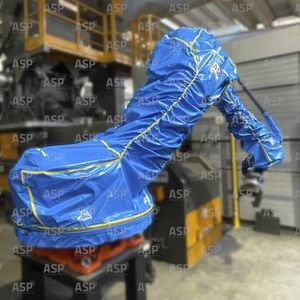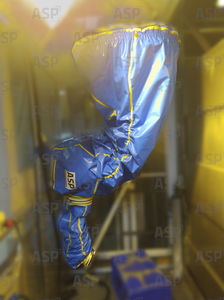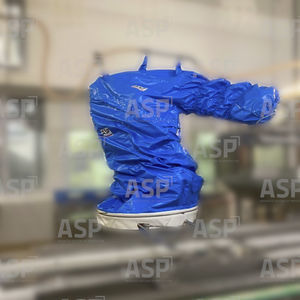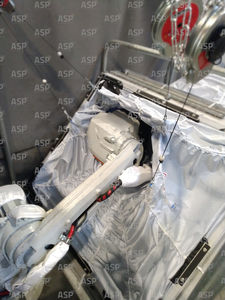
- Company
- Products
- Catalogs
- News & Trends
- Exhibitions
High-temperature protective cover TP62 / TORCAL B+for robotswaterproofcustom
Add to favorites
Compare this product
Characteristics
- Application
- for robots
- Options
- waterproof, custom, high-temperature, silicone-free
- Domain
- for the automotive industry
- Certifications
- RoHS 2
Description
Insulating and waterproof protective covers.
Integrated dehumidifier to dry the air under the cover.
Washable and repairable robot protection.
“Multilayer” protective covers to minimize heat exchange.
Stainless steel/composite rotary seals on axes 1, 4, and 6.
Specific air handling.
Air network protected by “multilayer” ducts.
On-site setup of the air handling system (1 to 2 days of on-site testing).
Robots used in climatic chambers are subjected to significant temperature variations and need to be protected against both heat (+60°C) and cold (-20°C). ASP technologies heat or cool the air between the cover and the robot’s surface, as required, so that the robot can work in optimum conditions, without suffering damage or requiring maintenance or parts replacement.
For these environments, ASP recommends full robot protection to prevent moisture formation. ASP takes into account the robot’s trajectories to define the most suitable solution, including the integration of rotating seals on axes 1 and 4 if necessary.
In the automotive sector, spare parts need to be tested in chambers that can reproduce extreme climates such as desert, tropical, or extreme cold conditions. For example, the robot may open and close consoles, individual parts or areas may be tested under extreme negative temperatures and intense heat to systematically detect quality defects before production. Therefore, it is essential to protect your robot with an ASP climate solution.
Your constraints:
Cold, hot, or humid environment
Regular maintenance
Robots that are not adapted to extreme conditions
Process constraints
High temperature >+60°C | Humidity | Low temperature -20°
Catalogs
No catalogs are available for this product.
See all of ASP‘s catalogsRelated Searches
- Robot protective cover
- Waterproof protective cover
- Custom protective cover
- Industrial protective cover
- Protective cover for the automotive industry
- Metal machining protective cover
- Dust-resistant protective cover
- Machine safety protective cover
- Forge robot protective cover
- Foundry robot protective cover
- High-temperature protective cover
- Fire-resistant protective cover
- Handling robot protective cover
- Protective cover for the food industry
- Protective cover for the aeronautical industry
- Painting robot protective cover
- Liquid-resistant protective cover
- Welding robot protective cover
- Anti-static protective cover
- Cutting robot protective cover
*Prices are pre-tax. They exclude delivery charges and customs duties and do not include additional charges for installation or activation options. Prices are indicative only and may vary by country, with changes to the cost of raw materials and exchange rates.


























